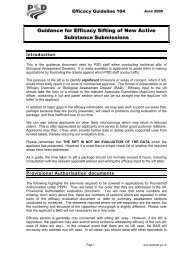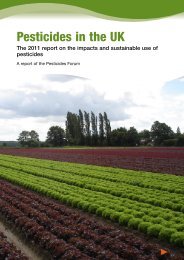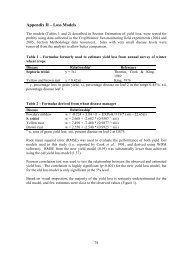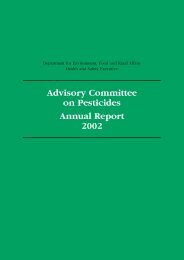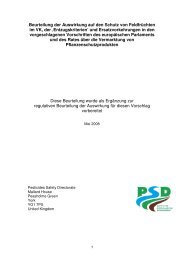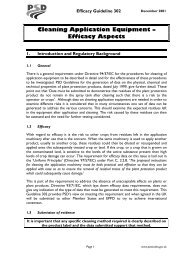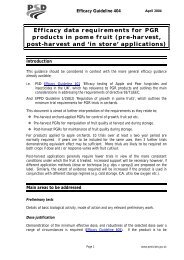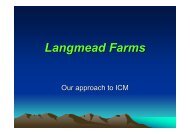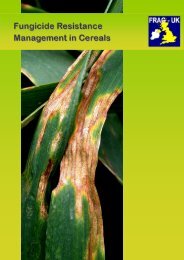Advisory Committee on Pesticides Annual Report 2001
ACP Annual Report 2001 - Pesticides Safety Directorate
ACP Annual Report 2001 - Pesticides Safety Directorate
You also want an ePaper? Increase the reach of your titles
YUMPU automatically turns print PDFs into web optimized ePapers that Google loves.
Secti<strong>on</strong> F: Other items c<strong>on</strong>sidered during the year<br />
from 56 percent to 32 percent. This may have been due to the increased<br />
uptake of crop assurance schemes, whose aim is to prevent the c<strong>on</strong>taminati<strong>on</strong><br />
of stored products, from rodent damage/fouling and from accidental spillage<br />
of rodenticide bait inside buildings.<br />
The proporti<strong>on</strong> of rodenticides purchased as c<strong>on</strong>centrates in 1998 remained<br />
close to a quarter of the total principal active substances used, as in 1996.<br />
There had been a decrease in the use of ready-to-use formulati<strong>on</strong>s from<br />
47 percent in 1996 to 39 percent in 1998 and also a subsequent increase<br />
in both c<strong>on</strong>tact dusts (20 percent in 1996 to 22 percent in 1998) and sachets<br />
(11 percent to 13 percent).<br />
There had been a further rise in the amount of bait applied by farmers as<br />
opposed to c<strong>on</strong>tractors. In 1994 farmers applied 55 percent of the principal<br />
six active substances. In 1996 this had risen to 75 percent, and in 1998 farmers<br />
applied 82 percent. This may have resulted from the increasing cost of<br />
employing a c<strong>on</strong>tractor as well as an increase in the number of the ’user<br />
friendly’ formulati<strong>on</strong>s available <strong>on</strong> the market such as sachets, c<strong>on</strong>tact dusts<br />
and wax blocks.<br />
<strong>Report</strong> 164: Protected crops (edible and ornamental) in<br />
Great Britain 1999<br />
This report presented informati<strong>on</strong> <strong>on</strong> all aspects of pesticide usage <strong>on</strong><br />
protected crops, both edible and ornamental, grown in Great Britain in 1999.<br />
More than 188 distinct crop types were encountered in the survey and data <strong>on</strong><br />
pesticide usage were collected during visits by pesticide usage surveyors to<br />
377 holdings throughout Great Britain. The total area surveyed represented<br />
30 percent of the area of all protected crops grown in Great Britain in 1999,<br />
while the area visited in each regi<strong>on</strong> was proporti<strong>on</strong>al to the area of protected<br />
crops grown in that regi<strong>on</strong>. The data <strong>on</strong> the area of pesticide treatments and<br />
the amounts of active substances applied had been extrapolated to give<br />
estimates of nati<strong>on</strong>al pesticide usage <strong>on</strong> protected crops. Informati<strong>on</strong> was<br />
also presented c<strong>on</strong>cerning the extent of usage of biological c<strong>on</strong>trol agents.<br />
65<br />
Edible crops accounted for 38 percent of the total area of protected crops<br />
grown in 1999.<br />
Usage of all biological c<strong>on</strong>trol agents accounted for 51 percent of the total<br />
treated area for pest, disease and weed c<strong>on</strong>trol <strong>on</strong> edible crops, although no<br />
such usage was recorded <strong>on</strong> lettuce, celery or edible plants in propagati<strong>on</strong>.<br />
Fungicides accounted for 27 percent of the total treated area, insecticides<br />
14 percent, acaricides three percent and sulphur two percent.




